Abstract
The history of the Carriqueo Lof
The Mapuche Carriqueo community is located 11 kilometers from the tourist city of San Carlos de Bariloche, in the Argentine Patagonia. Rudecindo Rozas and Adelaida Vazquez —paternal grandparents of Susana Carriqueo, who lives with her family in the territory—, arrived from Chile around 1900. The family’s history can be traced back to those days until the present. They have always kept a close bond with the water courses that surround the territory and that shaped and conditioned their traditions and learning during their childhood. However, they also acknowledge the changes that their daily livelihoods have undergone because of tourism ventures, river pollution, and growing unplanned development.

2. Photo. The Carriqueo Lof Area
3- Video. On the Banks of the Gutiérrez Creek
The city of San Carlos de Bariloche is one of Argentina´s tourist hotspots. It is internationally known for having the largest ski center in Latin America and for the natural beauty that surrounds it. In the last thirty years, tourism development and the number of people choosing to move and settle in this Patagonian city have increased in equal measure. This has resulted in infrastructure changes and high levels of pollution and contamination of the area´s flora, fauna, and environment at large. In addition to this, the historical tensions between private businesses, the Argentine Army and the Indigenous communities have become more relevant in recent years, leaving the claims of the families in a situation of vulnerability and exposure, as in the case of the Carriqueo family, who have been living for more than three generations in the territories that the Argentine State has not yet recognized as their own. The territory of the Lof, which covers two and a half hectares, does not have any official recognition to date, although the community formally requested that a territorial survey be conducted under the umbrella of Federal Act No. 26.160. The need for this act to be enforced arises from the pressure they have been suffering for years at the hands of various actors who have occupied part of their territory and who use this area as a waste dump. The territory currently known as Patagonia was the scene of a genocide carried out by the Argentine and Chilean states in their formative stages. In the last decades of the 19th century, the Argentine army persecuted, murdered, kidnapped, imprisoned, and tortured thousands of Indigenous people who lived freely in their territories. The surviving families and communities belonging to the Mapuche people were displaced from their homeland, taken to concentration camps, or deported as cheap labor to various cities. This process occurred on both sides of the Andes Mountains. In the memory of these families, the decision to move from their places of origin to other areas —as is the case of the members of the Carriqueo community—, responds to survival and collective strategies following the genocide. Over the years, another survival mechanism was the silencing and neglecting of ancestral or idiomatic customs or practices. However, much of the knowledge was transmitted from generation to generation.
In 1938, Rudecindo was hired by the Federal Road Management and Transportation Administration to build dams and dikes from Puerto Moreno Sur to Virgen de las Nieves areas. These constructions are still in use and organize the water course in that part of the city.
4- Video. Looking Back at the Dam´s Management
The couple bore children who eventually moved to nearby places. Their son José Alberto stayed there and married Ángela Carriqueo, who had escaped from a ranch in the Pichi Leufu area, her family´s native territory. The name of the Carriqueo community bears her surname in honor of this woman who was the one who cared for and respected the territory where her children had been born. As for the stories passed on from generation to generation, the Carriqueo family always described how life would take place around the streams, but also depicted with much pain the time when everything started to change as a consequence of the pollution of waters and the undue urban development that took place around them. At present, the third, fourth and fifth generations in the family inhabit the land. Amid the growing urban development, they embrace a partially rural life.
Memories of a Unique Landscape

5 - Photo. Susana Carriqueo on the banks of the Gutiérrez canal
The Community´s territory is surrounded by two water courses: the Gutiérrez creek and a canal bearing the same name, and formed by the diversion of that same stream.

6 - Satellite Image Caption: A community surrounded by water
Upon entering the Lof, one has the feeling of being in the presence of a natural reserve lying in sharp contrast with the progress and urbanization that surrounds the area. The poplars planted by grandmother Adelaida continue to grow on the banks of the river amid the vast extensions of grasslands. During the tours around the place, its members recall the uses and forms that the landscape where they live today formerly had. They narrate how animals would populate the banks of the creeks. They would describe a continuous presence of huillines —a species of carnivorous mammals belonging to the Mustelidae family that inhabits aquatic environments in Chile and Argentina—, along with endemic Patagonian otters that are in danger of extinction. The community also recalls how the wickerwork around the stream would be devoted to making basketry objects, while the reeds would be used to create curtains. It was customary to take long baths in the water. The colors of the sorbus leaves —or rowan of the hunters, tree of the rosaceae family genus— that grew along the stream formed an autumn frame of sheer beauty, so much so that painters of the caliber of José Evaristo Repossini would request permission to portray this landscape.

7 - Image “Otoño” [Autumn], Evaristo Repossini, oil on canvas, 1959. Source: galeriapremier.com.ar.

8 - Photo The Lof in Autumn
“Heartfelt Words of Care” Inherited
Through the generations, the Mapuche people passed on advice, regulations, and protocols on how to protect the diversity of lives that inhabited their territories; but, above all, they transmitted “heartfelt words of care” on the importance of honoring, every day, the bond of reciprocity and affection that had always existed among beings living together in the same abode. Their ancestors had left these nurturing words as a treasure in the Carriqueo community. This is why today they embrace this commitment as their own, draft their own rules and regulations for the preservation and protection of nature, and commit to comply with them. For example, the Carriqueo family believes it is particularly important to keep the stream clean. For this reason, the children´s diapers should never be washed in the water, the fish should be cleaned far from the stream, and certain rules should be observed for bathing in the water. Everyone remembers how Ángela Carriqueo would take care of the water and the territory, and how she would instruct her sons and daughters to do so through stories, mirroring behavior, and giving advice. “The water would always be impeccable,” Susana recalls.
9 - Video. Susana Carriqueo´s nostalgia over the canal´s former water purity
A Word of Advice and Knowledge on the River
In the memory of community members, stories and anecdotes about fishing come up with different highlights. There are those in which José Alberto would organize for his sons and daughters to go fishing with him, taking some kind of harpoons and small boats that he had built to this end.
10 - Video. Subsistence activities and work
They would catch large trout that they would then use for their own consumption, but most of the time they would sell them to neighbors and hotels in the area. Fishing was so abundant that they would fill large 200-liter barrels with the fish. They would also recall that when they were children, they would wake up at four in the morning and go with lanterns or candles to the banks of the stream to fish before going to school.
11 - Video. Traces of family fishing
In turn, people in the area would ask for permission to come down to the shore and spend the day fishing. On occasion, they would give them the day´s catch as a gift. The Carriqueo family even created a lagoon from the canal to raise and breed fry (newly hatched fish).
Life in the Territory
They had at least three orchards in the territory, all of which were supported by an irrigation system built by Susana´s father, running from the creek to the plantations. The family consumed the vegetables, although they would also be sold to nearby neighbors or at the fairs. The women of the community recall that when they were children, they would go from the stream to the orchard with buckets full of water so that the vegetables would not go to waste. They also remember that they used to move firewood from one end of the area by throwing the logs upstream and catching them at the stockpiling place, where they would be secured with hooks to retrieve them from the water. Upon walking through the territory, you may still find traces of the activities carried out over three generations: the stand or scrubbing surface built to wash clothes on the banks of the creek, the spots on the riverbanks where they would go to fish, the bends in the riverbed where they would bathe, and the water irrigation outlet that would take water to the vegetable gardens.
Pollution and the Disruption of Daily Life
12 - Video. Pollution of the Gutierrez Creek
About 30 years ago, the community started to notice health problems in children and neighbors living nearby. They would recall babies suffering from skin problems, gastroenteritis, and diarrhea. Susana can clearly recall how a neighbor had started with stomach problems and become seriously ill because of drinking the water. As soon as they realized these events were linked to water contamination, they initiated an investigation process. A neighbor then told them that the water had been contaminated because the ski resort was discharging sewage into the Gutiérrez stream. The community´s and neighbors´ concern was such that they pressed to have the water analyzed. The study finally confirmed that the water was “not fit for human consumption.” As a result, the livelihoods of the Carriqueo community were strongly disrupted. They would now have to travel to a spring to get drinking water and they would no longer bathe in the water because it would affect their skin. According to Susana, the water was no longer clear or crystalline and the stones in the waterbed were covered by a brownish substance. The surface would show bubbles indicating the presence of bacteria. The fish would also evince the effects of contamination: when opened, worms and spots would be visible. In 2007, Erasmo Maldonado, Susana´s husband, filed a media complaint describing the state of the stream following the winter tourist season.
In 2016, the community requested a new analysis of the water quality of the Gutiérrez stream. The reports of all the analyses historically conducted were unanimous: the water quality “is not suitable for human consumption” (see Complaints and Reports on Water Quality).
Territorial Dispossession
In addition to the water contamination scenario, the people must face the advances of private companies that invade the Community´s territory by means of wire fences and real estate agreements of dubious origin, and the constant pressure exerted by the Argentine Army on their territory.
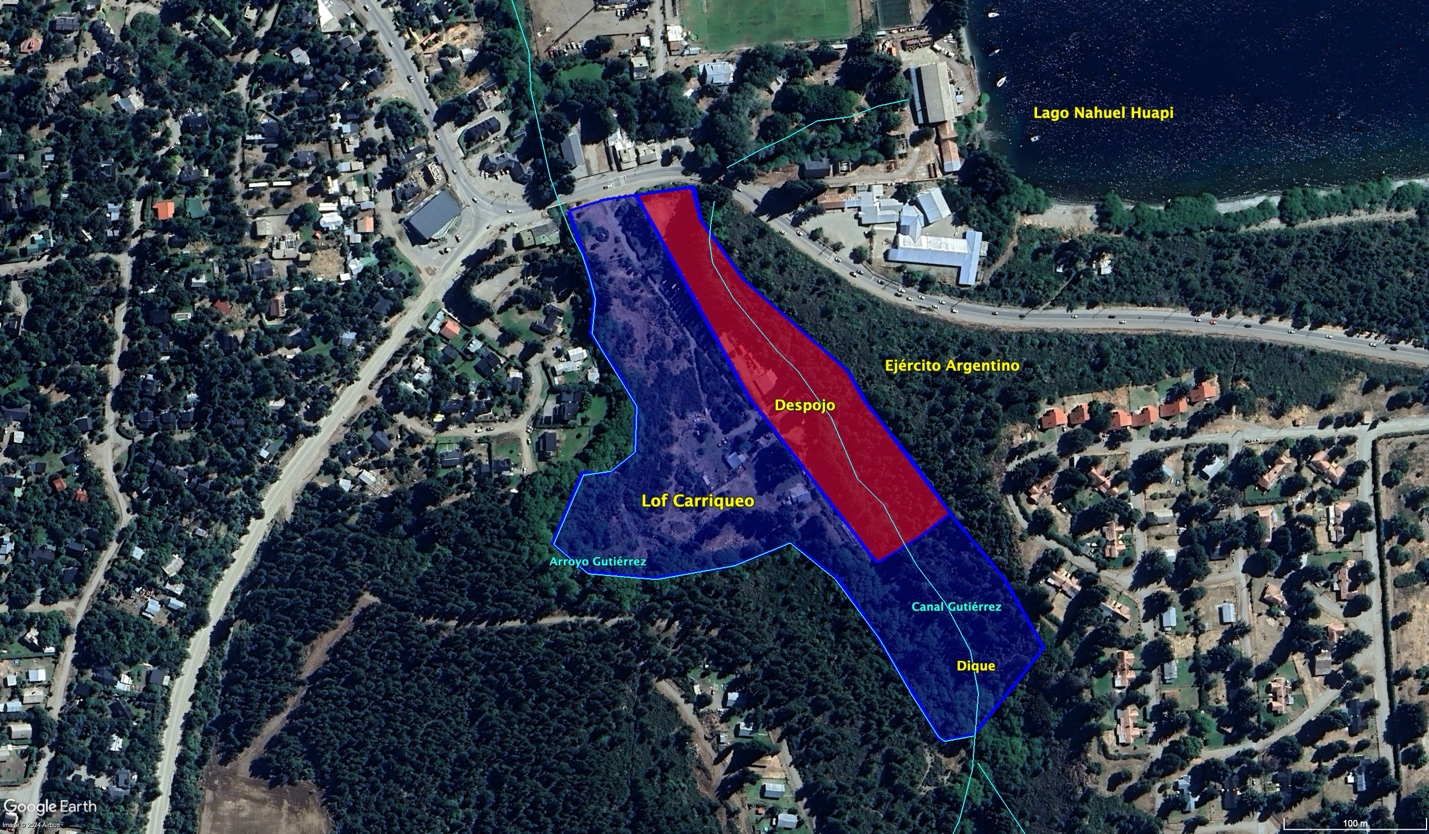
13 - Satellite Image. Territorial dispossession
Private companies have placed “no trespassing” signs along the canal where the family used to live, scattered scrap metal, and put up wire fences.
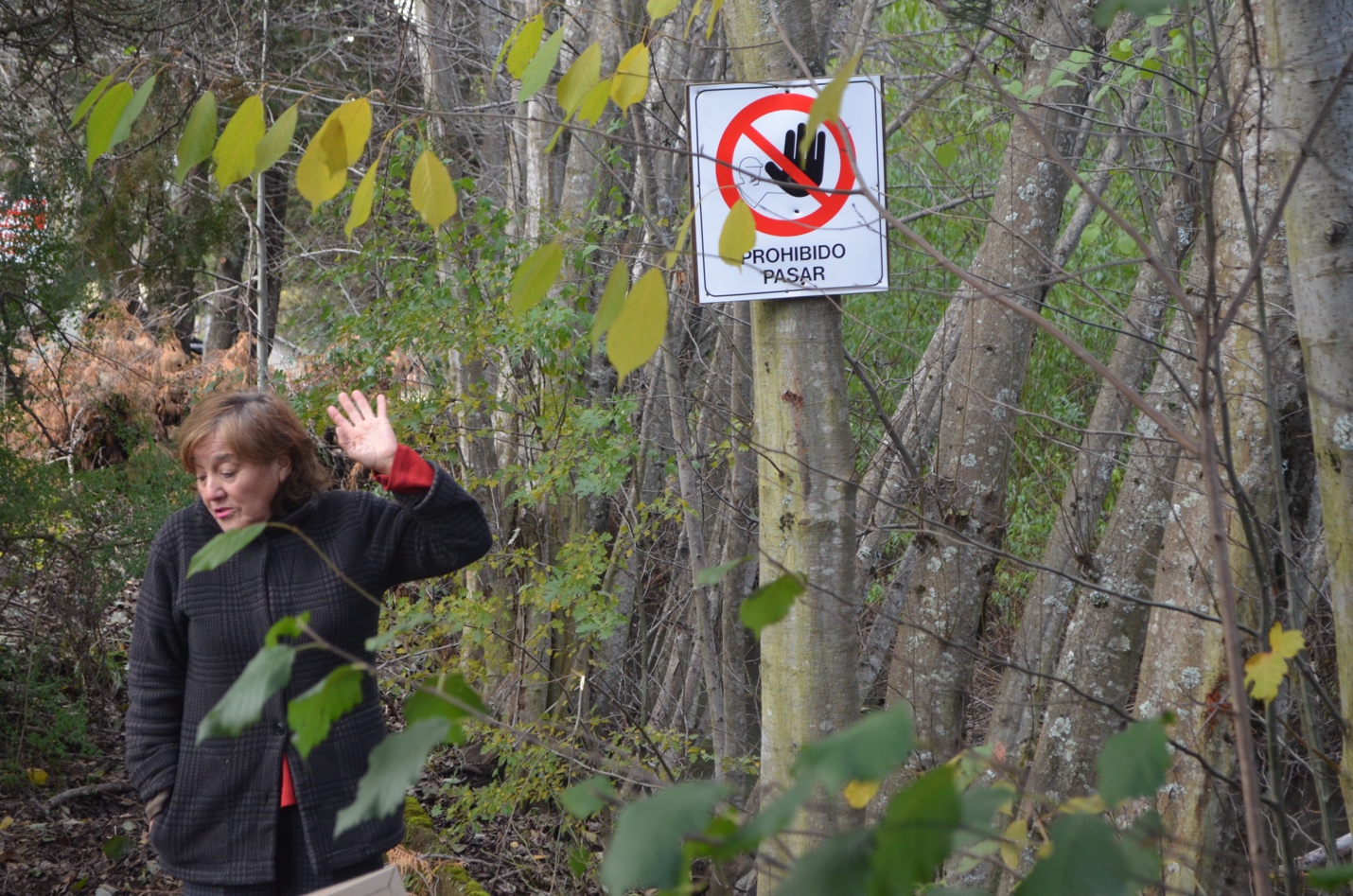
14 - Photo. Signs forbidding access into Carriqueo Lof, reminding everyone of the dispossession
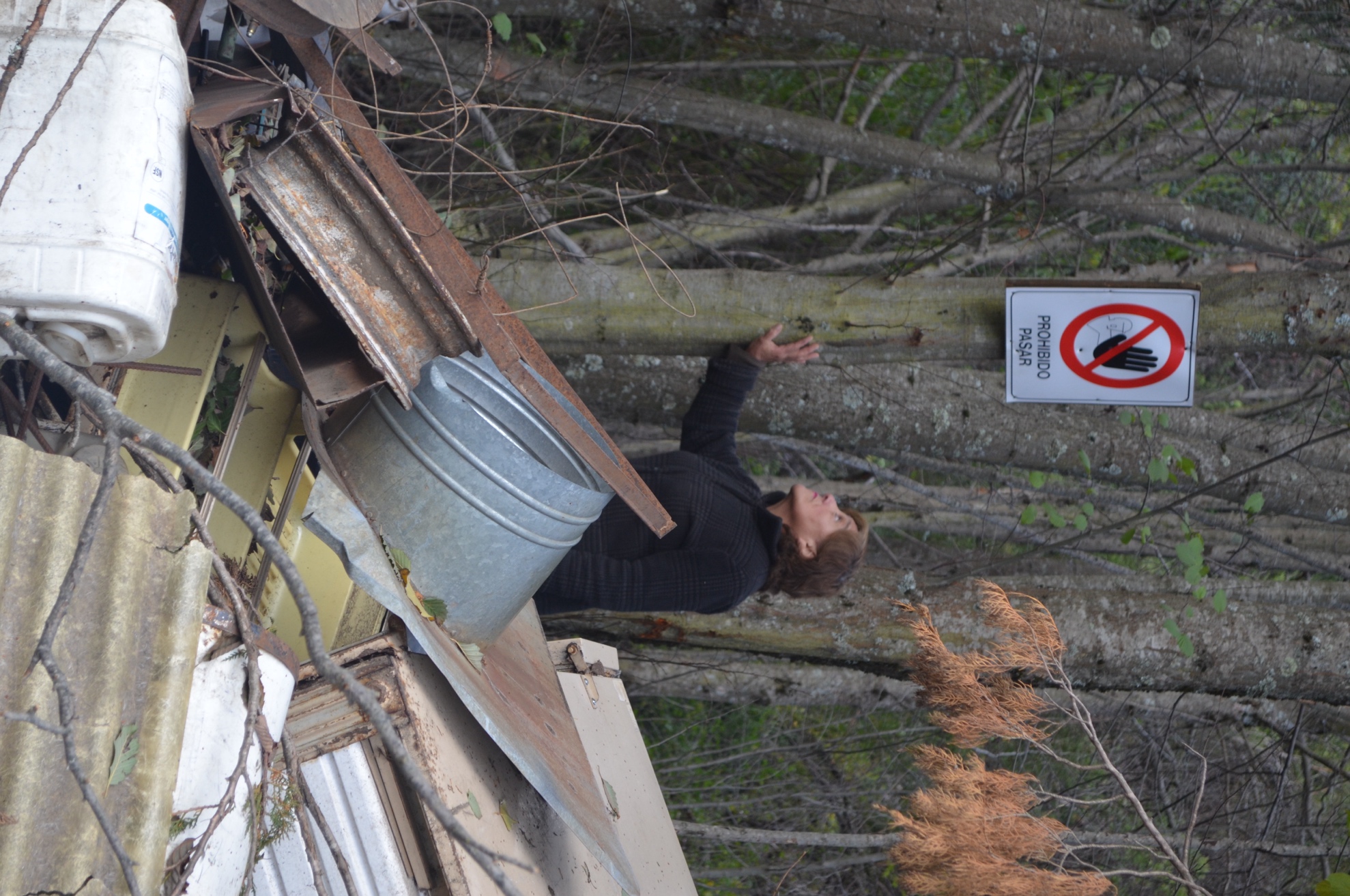
15 - Photo. Caption: Scrap that the usurpers of the Carriqueo Lof are stockpiling
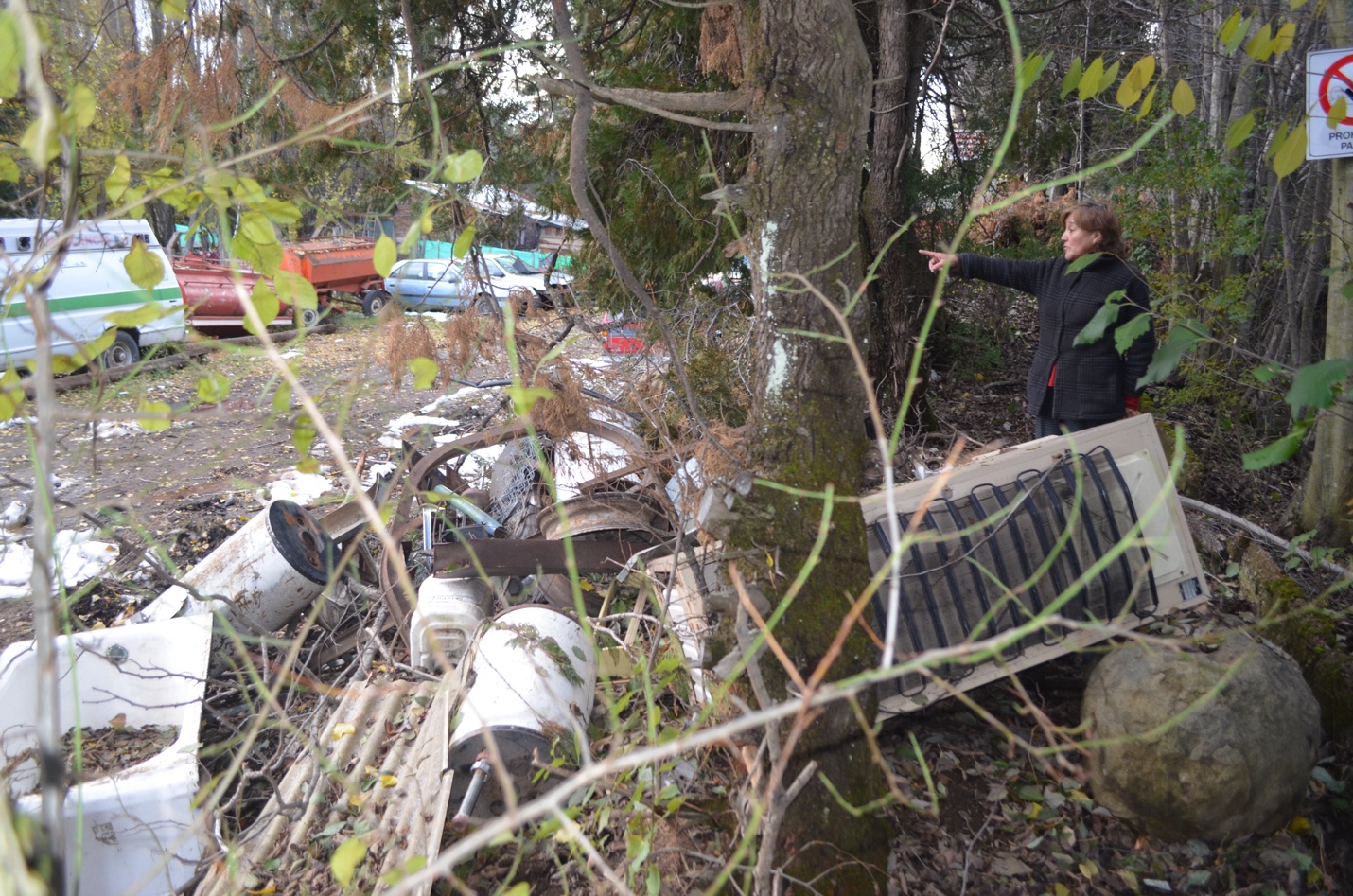
16 - Photo. Caption: Lof Carriqueo turned into a garbage dump by the usurpers
17 - Video. Evidence of the destruction perpetrated by the usurpers
Final reflections: a Community in Defense of its Territory
The history of the Carriqueo Lof tells the story of a Mapuche family living in a territory of unique natural beauty. Generation after generation, they have learned to care for and enjoy their environment, and have passed this knowledge on to the succeeding generations. Their memory is full of anecdotes about the waters that surround them: games, subsistence, work, landscape, care, and tragic accidents. The canal and the Gutiérrez stream embrace the territory as if containing it, taking care of it. However, this embrace has not been enough to protect the territory from outsiders. Argentina´s history of persecution of Indigenous peoples and dispossession of their territories include the Mapuche Carriqueo community. Both the Argentine Army and various private parties have pressured the Lof to take over their territory through swindles, demands and hostility. Despite the family´s unwavering efforts to obtain official recognition of their place in the world, they have not yet succeeded in doing so. On the contrary, they systematically continue to receive eviction orders and the prohibition —through signs and through the presence of usurpers—, to access the sector within their territory where the Gutiérrez canal built by Susana Carriqueo´s grandfather is located. The water courses surrounding the community have also been insufficient to prevent the advancement and consequences of the gentrification process. The beauty of San Carlos de Bariloche city and its surroundings has attracted capital for the development of the tourist industry: ski resorts, hotels, restaurants, and a significant inflow of tourists. This development has not been framed within regulations seeking to avoid and halt the harmful effects on the population and the environment. Thus, the Carriqueo family —with much regret and longing—, is a privileged witness not only to the dispossession, but also to the degradation of their environment. The waters are polluted, the fauna moves away or becomes extinct, the vegetation disappears, the people get sick, the territory is transformed into a place where waste piles up. Despite everything, the love for their land and the strength to respect their elders´ teachings are unwavering. With firm determination, the Carriqueo Lof does not cease to submit their complaints to the authorities and to take care of their territory.
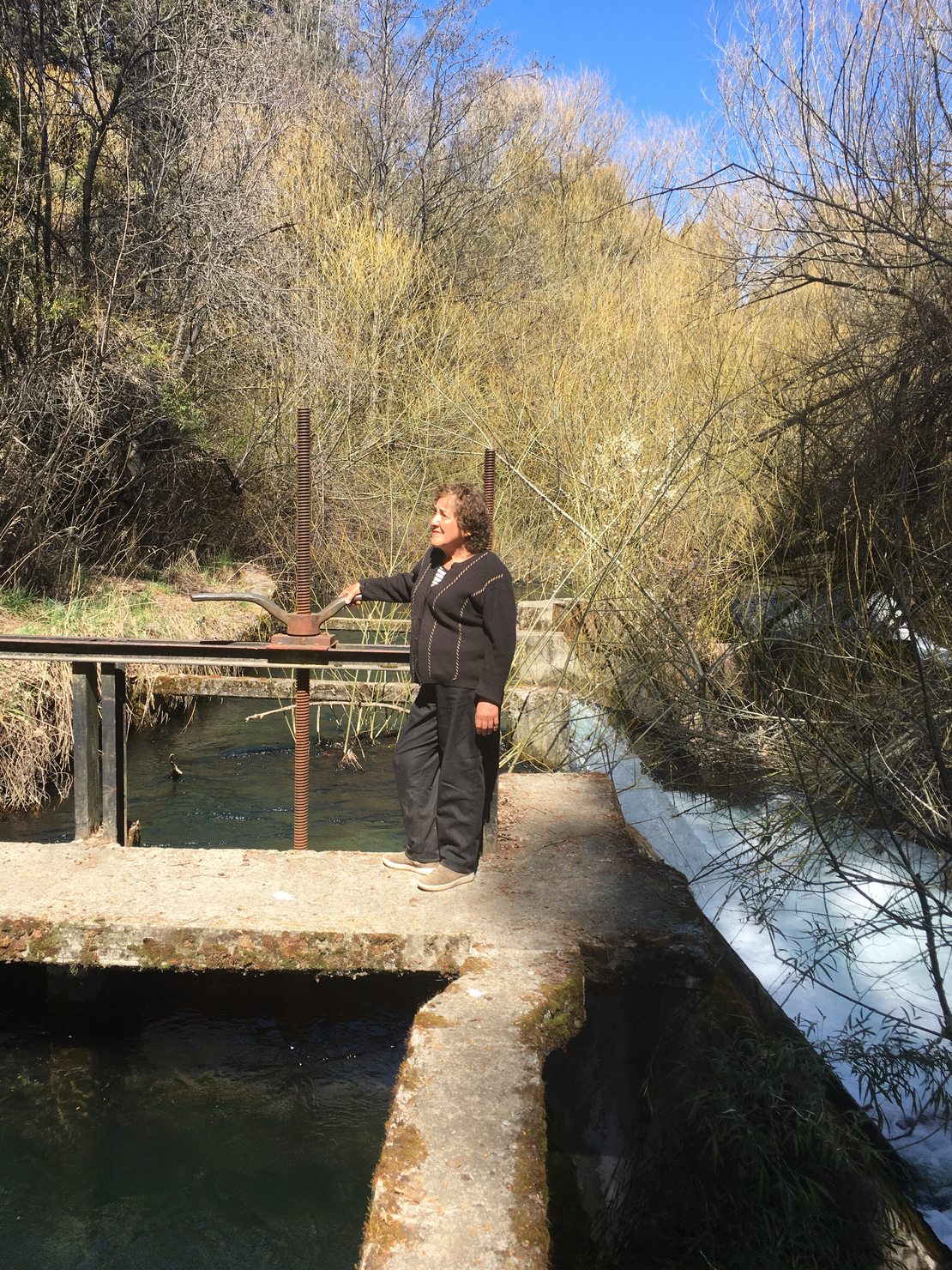
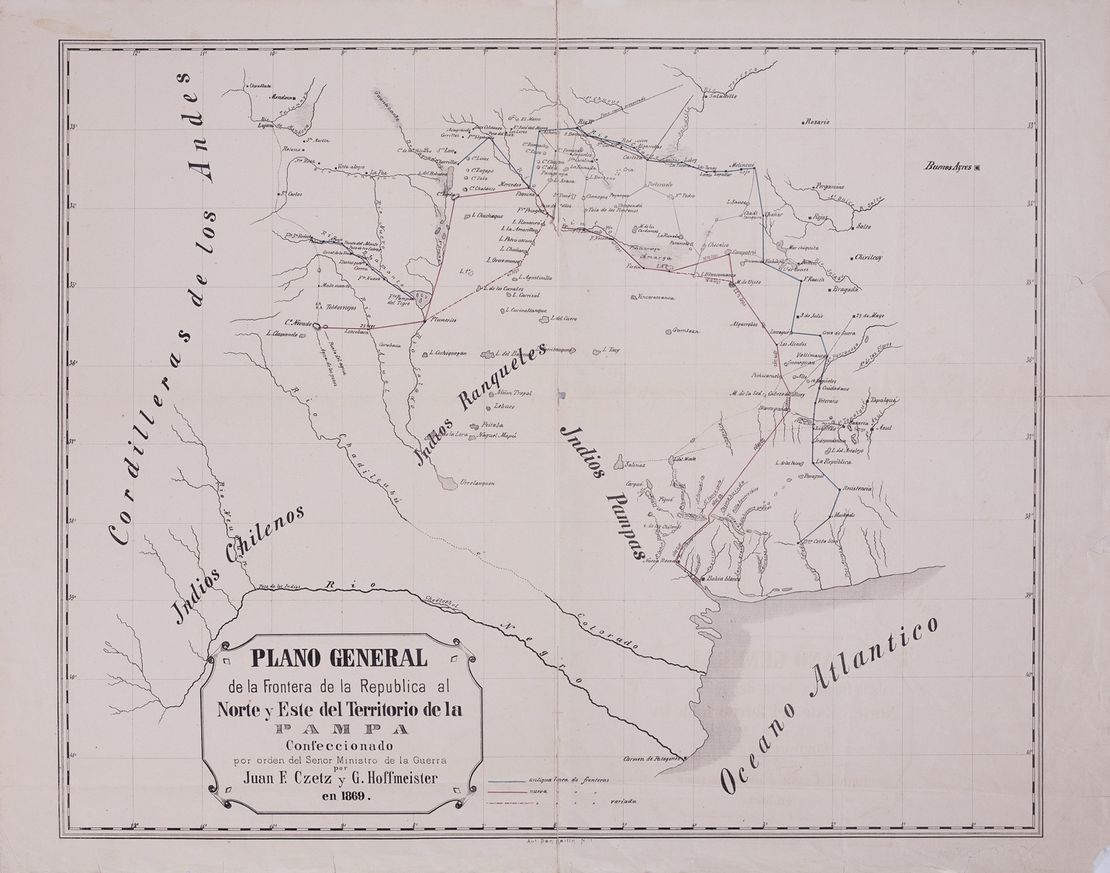
![Kowkülen [Liquid being]](https://dnet8ble6lm7w.cloudfront.net/art_sm/AECU003.png)